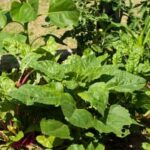Are you looking for a cost-effective and sustainable way to start your own vegetable garden? One innovative solution is vegetable gardening with pallets.
Pallets are versatile and can be repurposed for various DIY projects, including creating a functional and productive garden space. In this article, we will explore the benefits of using pallets for vegetable gardening, how to choose the right pallets, preparing them for planting, the best vegetables to grow in pallet gardens, tips for maximizing space and yield, maintenance and care, as well as creative ideas for DIY pallet garden designs.
When it comes to sustainable gardening practices, utilizing pallets can be an excellent way to repurpose materials that might otherwise go to waste. Not only does this approach help reduce environmental impact by reusing materials, but it also offers numerous advantages for the home gardener. Whether you have limited space or simply want to create a unique and visually appealing garden, vegetable gardening with pallets can provide an exciting and rewarding experience.
In the following sections of this article, we will delve into the various aspects of vegetable gardening with pallets to help you get started on your own sustainable garden project. From selecting the right pallets to maintaining your garden throughout the growing season, we will provide you with valuable tips and insights on how to make the most of this innovative gardening method.
Let’s explore the world of pallet gardening and discover how you can cultivate an abundant harvest in even the smallest of spaces.
Benefits of Using Pallets for Vegetable Gardening
One of the main benefits of using pallets for vegetable gardening is their cost-effectiveness. Pallets are often readily available for free or at a low cost, making them an affordable option for creating raised garden beds. This is especially beneficial for those who are looking to start a garden on a budget or in a small space.
Additionally, using pallets for vegetable gardening can contribute to sustainability efforts by repurposing materials that might otherwise go to waste. By upcycling pallets into garden beds, gardeners can reduce their environmental impact and promote a more eco-friendly approach to gardening.
Another advantage of using pallets for vegetable gardening is the versatility they offer in terms of design and layout. Gardeners can easily customize the size and shape of their raised beds by simply adjusting the positioning of the pallets. This flexibility allows for a greater level of creativity in designing unique and functional garden spaces.
In summary, the benefits of using pallets for vegetable gardening are numerous. From affordability and sustainability to flexibility in design, pallets offer an attractive option for those looking to create their own sustainable and productive gardens. Whether you are a novice gardener or an experienced enthusiast, considering vegetable gardening with pallets can be a rewarding and practical choice.
Choosing the Right Pallets for Your Garden
When it comes to vegetable gardening with pallets, choosing the right pallets for your garden is essential for a successful and sustainable harvest. Pallets are often used in gardening due to their accessibility, affordability, and versatility. However, not all pallets are created equal, and selecting the appropriate ones can make a significant difference in the success of your garden.
Material and Safety Considerations
When choosing pallets for your garden, it’s crucial to consider the materials they are made of. Opt for pallets that are heat-treated (HT) rather than those treated with chemicals like methyl bromide (MB). HT pallets are safer for growing vegetables as they have been treated with heat to control pests and pathogens, while MB-treated pallets may contain harmful chemicals that can leach into the soil and affect your plants.
Size and Design
In addition to materials, consider the size and design of the pallets. Look for pallets that are well-constructed and sturdy enough to support the weight of soil, water, and plants. You may also want to choose pallets with wider slats to provide more space for plants to grow and thrive.
Sourcing Pallets
Pallets can be sourced from local businesses, warehouses, or recycled from shipping companies. When obtaining pallets from these sources, always ask for permission before taking them. It’s also important to inspect the pallets thoroughly for any signs of damage or contamination before using them in your garden.
By carefully selecting the right pallets for your vegetable garden, you can create a sustainable and productive growing space while minimizing environmental impact. Remember to prioritize safety and quality when acquiring pallets for your garden to ensure a bountiful harvest of healthy and delicious vegetables.
Preparing the Pallets for Planting
When it comes to vegetable gardening with pallets, preparing the pallets for planting is a crucial step in ensuring a successful and thriving garden. Before planting any vegetables, it’s essential to properly prepare the pallets to create an optimal growing environment for your plants.
One of the first things to consider when preparing pallets for planting is their previous use. Make sure that the pallets were not used to transport any harmful chemicals or substances that could leach into the soil and affect your vegetables.
To prepare the pallets, start by giving them a good clean with water and a mild soap to remove any dirt, debris, or potential contaminants. Once they are clean, allow them to dry thoroughly before moving on to the next step. After cleaning and drying the pallets, consider lining them with landscape fabric to prevent soil from spilling out between the slats. This will help keep your garden looking neat and contained while also maintaining good drainage for your vegetables.
An alternative option for preparing pallets for planting is to add a layer of plastic sheeting on the inside walls of each section before adding soil. This will help protect the wood from moisture and extend the life of your pallet garden.
Additionally, if you choose to paint or seal your pallets, make sure you use non-toxic products that won’t harm your plants or soil. Overall, taking these steps in preparing your pallets will ensure a healthy and productive vegetable garden.
| Preparation Steps | Description |
|---|---|
| Clean Pallets | Thoroughly clean pallets with water and mild soap |
| Add Landscape Fabric | Line pallet sections with landscape fabric to contain soil |
| Protective Coating | Add plastic sheeting or non-toxic sealant/paint for added protection |
Best Vegetables to Grow in Pallet Gardens
When it comes to vegetable gardening with pallets, there are a variety of options to consider for what you can plant in your pallet gardens. Whether you have limited space or simply want to try something new, growing vegetables in pallets can be a rewarding experience. Here are some of the best vegetables to consider planting in your pallet gardens:
- Tomatoes: Tomatoes are well-suited for growing in pallet gardens, as they can thrive in the confined space and vertical structure that pallets provide. They also do well when trained to grow upwards using strings or trellises.
- Lettuce and other leafy greens: Leafy greens like lettuce, spinach, and kale are perfect for pallet gardens due to their shallow root systems. You can easily grow these vegetables in the gaps between slats or in small containers attached to the pallet.
- Herbs: Herbs such as basil, rosemary, and cilantro are ideal for pallet gardens because they don’t require a lot of space to grow. You can plant them directly into the soil within the pallet or even use small pots inserted into the slats.
In addition to these options, other suitable vegetables for pallet gardens include radishes, carrots, peppers, and strawberries. It’s important to consider the specific needs of each plant when planning your pallet garden layout. Keep in mind factors such as sunlight exposure, watering requirements, and compatibility with neighboring plants.
Ultimately, one of the key advantages of vegetable gardening with pallets is the versatility it offers in terms of what you can grow. With some creativity and strategic planning, you can utilize every inch of space on your pallets to produce an abundant harvest of fresh vegetables and herbs.
Tips for Maximizing Space and Yield in Pallet Gardens
When it comes to vegetable gardening with pallets, maximizing space and yield is essential for a successful and productive garden. There are several tips and techniques that can help you make the most of your pallet garden, allowing you to grow a wide variety of vegetables in a small space.
One effective way to maximize space in a pallet garden is by using vertical gardening techniques. Pallets are perfect for vertical gardening as they can be easily stacked or leaned against a wall to create more planting space. This not only maximizes the use of limited space but also provides better airflow and sunlight for your plants.
Another tip for maximizing yield in a pallet garden is to choose the right vegetables to grow. Opt for compact and high-yielding vegetable varieties that are suitable for small spaces, such as lettuce, radishes, cherry tomatoes, and peppers. Additionally, consider companion planting to make the most of the available space and improve plant health and productivity.
Furthermore, proper watering and fertilization are crucial for maximizing yield in pallet gardens. Since pallet gardens typically have limited soil volume, it’s important to water them regularly and efficiently to ensure that the plants receive an adequate amount of moisture. Implementing drip irrigation systems or self-watering containers can help maintain consistent soil moisture while reducing water waste.
| Maximizing Space in Pallet Garden | Maximizing Yield in Pallet Garden |
|---|---|
| Utilize vertical gardening techniques | Choose compact and high-yielding vegetable varieties |
| Implement companion planting | Ensure proper watering and fertilization |
Maintenance and Care for Pallet Gardens
Once you have successfully set up your vegetable gardening with pallets, it is important to know how to maintain and care for your garden to ensure a healthy and abundant yield. Regular maintenance not only keeps your plants thriving but also helps in preventing any potential issues that may arise.
One of the key aspects of maintaining a pallet garden is regular watering. With the limited space provided by pallets, it’s crucial to monitor the moisture levels of the soil to prevent drying out. Consider installing a drip irrigation system or hand watering daily, especially during hot and dry weather, to ensure that your vegetables are getting the hydration they need.
In addition to watering, regular inspection and weeding are essential for the upkeep of your pallet garden. Because pallet gardens are often raised and more contained than traditional gardens, they can be prone to weed growth. Taking the time to regularly inspect and remove any weeds will prevent them from competing with your vegetables for nutrients and sunlight.
Another important aspect of caring for a pallet garden is fertilization. Due to the confined space in pallet gardens, it’s crucial to replenish the soil with nutrients regularly. Consider using organic fertilizers or compost to provide essential nutrients for healthy plant growth.
Regular monitoring of pests and diseases is also vital in maintaining a healthy pallet garden. By inspecting your plants frequently, you can identify and address any pest or disease issues before they become severe.
By dedicating time and effort into maintaining and caring for your vegetable gardening with pallets, you’ll be well on your way to enjoying a bountiful harvest of fresh produce right from your own DIY garden.
Creative Ideas for DIY Pallet Garden Designs
When it comes to creating a DIY pallet garden, the possibilities are endless. With just a little creativity and some basic materials, you can turn a simple pallet into a beautiful and functional garden that will liven up any outdoor space. Here are some creative ideas for DIY pallet garden designs to get you started:
1. Vertical Herb Garden: Utilize the vertical space of a pallet by turning it into a herb garden. Simply attach small pots or containers to the slats of the pallet, fill them with soil, and plant your favorite herbs. Hang the pallet on a sunny wall or place it in a sunny spot in your yard for easy access to fresh herbs for cooking.
2. Succulent Wall Art: Create a living work of art by turning a pallet into a succulent wall planter. Fill the spaces between the slats with landscape fabric or burlap, add potting soil, and then plant an assortment of colorful succulents. Hang your succulent wall art on an outdoor fence or display it as unique decor on your patio.
3. Mobile Garden: Attach wheels to the bottom of a large pallet to create a mobile garden that can be easily moved around your outdoor space. This is perfect for growing vegetables that require different levels of sunlight throughout the day.
These creative ideas for DIY pallet garden designs are just the beginning. With some imagination and effort, you can transform ordinary pallets into stunning gardens that provide both beauty and functionality in any outdoor setting.
Whether you’re new to vegetable gardening with pallets or have been doing it for years, there are always new and innovative ways to design your space using these versatile materials.
Conclusion
In conclusion, vegetable gardening with pallets is a sustainable and practical way to grow your own produce at home. The use of pallets for gardening offers numerous benefits, including cost-effectiveness, space optimization, and ease of maintenance. As more people seek to live a more sustainable lifestyle and have limited space for traditional gardening methods, the future of vegetable gardening with pallets looks promising.
The trend of using pallets for growing vegetables continues to gain popularity as people become more conscious about where their food comes from and the impact it has on the environment. With the right preparation and care, pallet gardens can produce an abundant yield of fresh and nutritious vegetables year-round, even in small urban spaces.
As we look to the future, the potential for innovation in DIY pallet garden designs is exciting. There are endless creative ideas for utilizing pallets in unique ways to create beautiful and functional gardens. From vertical gardens to unique planter boxes, the possibilities for creating a sustainable and productive vegetable garden with pallets are endless.
With a bit of creativity and resourcefulness, anyone can turn a simple wooden pallet into a thriving vegetable garden. So why not give it a try and start your own vegetable gardening journey with pallets today?
Frequently Asked Questions
What Vegetables Can I Grow in a Pallet?
You can grow a variety of vegetables in a pallet, including lettuce, spinach, radishes, herbs, and even small root vegetables like carrots and beets. Pallets provide a versatile and space-saving option for urban gardening.
Are Pallets Safe for Vegetable Gardens?
Pallets can be safe for vegetable gardens if they are untreated and made of food-safe materials. It’s important to avoid using pallets that have been treated with chemicals or pesticides, as these can leach into the soil and potentially contaminate your vegetables.
Can You Plant Tomatoes in a Pallet Garden?
Yes, you can plant tomatoes in a pallet garden. Tomatoes are well-suited for growing in larger containers like pallets, as long as the pallet is deep enough to accommodate their root systems and has adequate drainage. Just make sure to provide support for the tomato plants as they grow.

If you’re looking to get into vegetable gardening, or are just looking for some tips on how to make your current garden better, then you’ve come to the right place! My name is Ethel and I have been gardening for years. In this blog, I’m going to share with you some of my best tips on how to create a successful vegetable garden.





